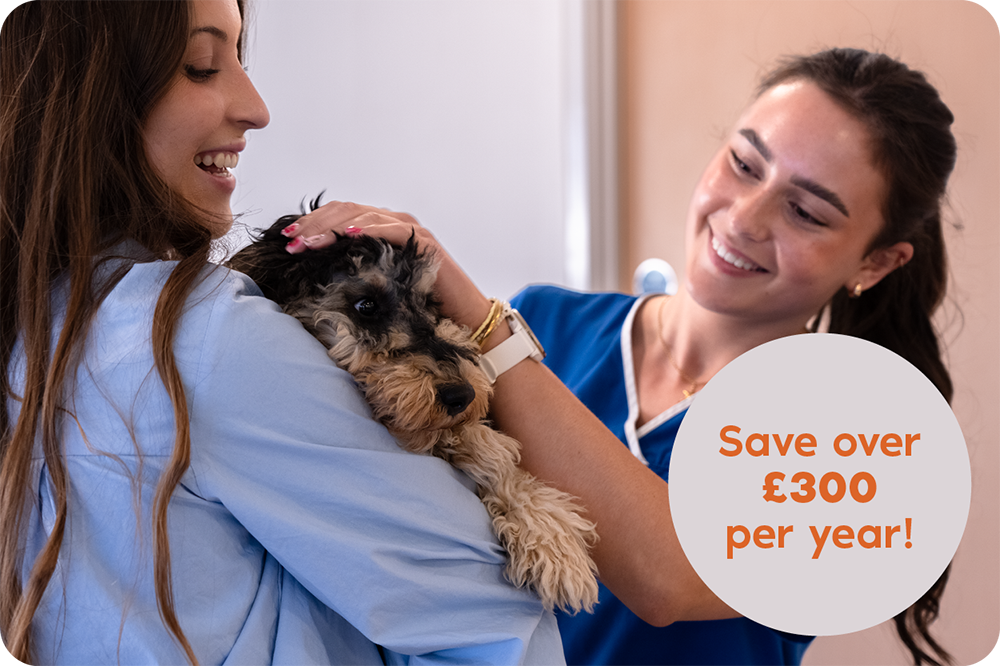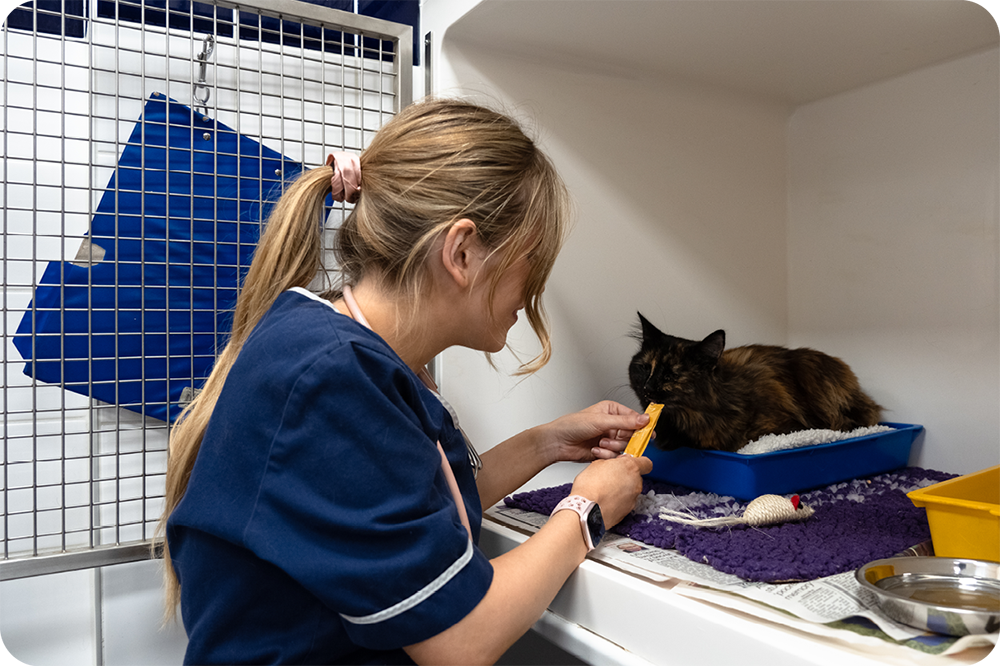Hyperthyroidism is one of the most common hormonal conditions affecting older cats, caused by an overactive thyroid gland in the neck. This can lead to a range of symptoms, including weight loss, increased appetite, and restlessness. While it can be alarming, the good news is that hyperthyroidism is manageable – and often curable – with the right treatment. In this article, we’ll explore what causes hyperthyroidism, how to spot the signs, and the various treatment options available to help your cat stay healthy and happy.
What is Hyperthyroidism?
Hyperthyroidism (or an “over-active thyroid gland”) is caused by a growth in the thyroid gland in your cat’s neck. These growths are normally benign, and only cause issues because of the hormones that they produce. Very rarely (around 2% of cases) we can see cancerous thyroid growths that may grow rapidly and spread round the body.
Thyroid growths produce a variety of hormones, but the one we can measure easily in cats is thyroxine, or T4. The growths produce far more T4 than normal. Increased levels of T4 speed up the body’s metabolism, causing the symptoms of hyperthyroidism which include weight loss, increased hunger and thirst, restlessness, a high heart rate, and sometimes vomiting and diarrhoea.
What Causes Hyperthyroidism?
Hyperthyroidism in cats has become much more common over the last thirty years or so but the reasons for this are not entirely clear. Several different theories have been proposed, including different compounds found in food, water, or the general environment. Currently, there is no proven way to prevent cats from developing hyperthyroidism.
Treating Hyperthyroidism
There are several different ways to treat this condition. All of the options are effective, and we normally see cats’ symptoms significantly improved, or even completely reversed. However, some of the options are better for the long term than others.
Medication
Initially, all cats with hyperthyroidism are treated with medication. These medications reduce the production of T4, and so reduce the symptoms of hyperthyroidism. All the medications for hyperthyroidism are based around the same drug, variously called methimazole, thiamazole or carbimazole.
This drug comes in several different forms:
- Tablets or Liquid
These are oral medications that are given either once or twice a day. The tablet forms must go down whole – they cannot be crushed. The manufacturer recommends that liquid form be given directly into the mouth, but some of our clients put it on the food and still get good results. - Transdermal Gel
This is a form of methimazole that can be applied directly to the skin (usually the inside of the cat’s ear) with a gloved finger. From there, it is absorbed into the blood, and then gets to the thyroid from there. It is unlicensed, meaning it has not gone through rigorous safety and efficacy testing, and can only be used if the licensed versions (tablets and liquid) have been tried and are not possible. It does not seem to be as reliable as the oral versions, but some cats do well on it.
Whichever medication is used, your cat will initially need regular blood testing (every 3-4 weeks) to find the right dose to bring your cat’s T4 levels back to normal, and to monitor for any side-effects from the medication.
Once the right dose has been found, some owners choose to use this medication longer-term. This will mean continuing to give daily medication, and then being seen at the practice for a checkup and blood tests every 3-6 months. The dose of medication that cats need will normally increase slowly over time.
Surgery
The cause of hyperthyroidism is a benign growth, and one option for long-term management is surgery to remove this growth. Surgery will successfully cure hyperthyroidism in around 80-90% of cats.
However, a few cats will have thyroid tissue elsewhere in the body (usually inside the chest) which cannot be removed with surgery. These cats will still need some medication after surgery.
It is best to stabilise cats on medication before they undergo surgery, as this help to strengthen them and reduce their risk under the anesthetic.
The surgery itself does carry some risks, which your vet will discuss with you. Some cats need to be hospitalised for a day or two after the surgery.
Radioiodine Therapy
The “gold standard “of treatment for hyperthyroidism is therapy with radioactive iodine. T4 contains a lot of iodine, and so radioactive iodine is taken up by thyroid growths anywhere in the body, not just the neck. This kills these growths, and so potentially cures the hyperthyroidism complexly.
As with surgery, cats need to be stabilised on medication before having this treatment.
After the treatment, cats need to be hospitalised until they are no longer radioactive, which can be 2-3 weeks. Because of this, it may not be suitable for cats with other health problems.
There is a very high success rate with radioiodine treatment, with around 98% of cats being cured. Studies suggest that cats who have this treatment may live longer than those who are treated with medication alone.
Rarely, this treatment may damage the healthy thyroid gland, and cats may need long-term supplementation of thyroid hormone after the procedure.
Radioiodine is a specialist treatment, and not something that we can currently offer at our practice. If you are interested in this treatment, speak to your vet, who can discuss the closes treatment centers that offer this.
Diet Therapy
Hyperthyroidism can be managed using a diet that is ultra-low in iodine, called Hills y/d. As iodine is needed to make T4, removing most of the iodine from the diet prevents the thyroid growth from being able to create the large amounts of T4 that cause the symptoms of hyperthyroidism.
However, cats on this diet must eat nothing else—even a teaspoon of normal cat food is enough to undo the effects of the diet) and so is not suitable for cats who go outdoors.
Evidence suggests that this diet may not control the symptoms of hyperthyroidism as well as medication, but many cats can still get a good quality of life with this treatment.
What Is The Prognosis?
There are only a few studies that look at how long cats will live after being diagnosed and treated for hyperthyroidism. Generally, if cats are treated effectively and regularly monitored, they will live for several years after diagnosis. Cats who are treated with radioiodine appear to live for longer than cats who are given medication.
Unfortunately, cats who also have kidney disease when they are diagnosed with hyperthyroidism tend not live as long—usually less than a year.
Ongoing Monitoring
Blood Pressure
High blood pressure (hypertension) is common in all older cats, and those with hyperthyroidism are particularly at risk. Even cats whose hyperthyroidism appears to be under control may still develop high blood pressure, so we recommend that you cat’s blood pressure is checked regularly.
Urine
Urinary tract infections are common in cats with hyperthyroidism, but the symptoms of these can be difficult to spot. We recommend that urine samples are analysed regularly to check for any infection.
Kidney Disease
Some older cats may have both hyperthyroidism and kidney disease, as they are both common conditions, and the high blood pressure from hyperthyroidism may cause kidney damage.
However, this kidney disease may not initially show up on blood tests, as it can be hidden by the hyperthyroidism. Your vet may recommend checking your cat’s kidneys each time we take a blood sample, to make sure that there have not been any changes.
If kidney disease is detected on follow-up blood tests, your vet will discuss managing this with you.
Heart Tests
Hyperthyroidism can affect the muscles of the heart, causing them to thicken, which can lead to the heart not working properly. If your vet is concerned about your cat’s heart, they may recommend a blood test, or a heart scan, to check for any sign of a problem.
If you’re concerned your cat may have hyperthyroidism, or if they’ve already been diagnosed and you need guidance, we’re here to help. Contact your nearest practice today to speak with our caring veterinary team and ensure your cat gets the support they need.
Find a Vet Practice Near You
Our Latest News and Advice

Join our Pet Healthcare Plan, the Kin Care Club.
Our comprehensive pet healthcare plan is designed to help you give your cat or dog the best care, while keeping your budget in mind.
Whether you’re looking for essential coverage or complete peace of mind, the Kin Care Club offers two flexible plans tailored to your needs and your pet’s well-being.
